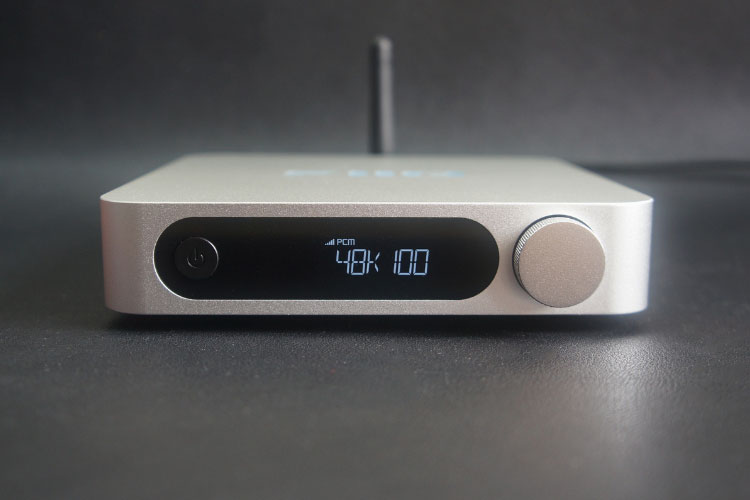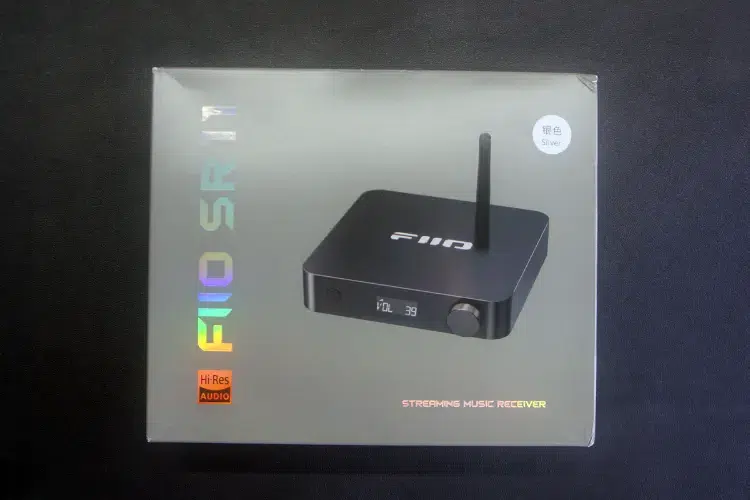Synergy
Based on my testing and preference, I found the SR11 did not add too much colorization to any given system and paired well with neutral-sounding AMP and headphone combinations.
The SR11 pairs well with the FiiO K11 and the MOONDROP Blessing 3. The K11’s neutral and natural tonality already paired well with the neutral presentation of the Blessing 3.
Adding the SR11 did not change much sonically, but the convenience made it easier to put on the IEMs and start listening immediately.
I also paired the SR11 with the K11 R2R DAC/AMP, xDuoo MT602 tube amplifier, and Audio-Technica R70x as a bedside setup.
I enjoyed this combination since it enabled me to experience the relaxing warmth of the R70x+Tube combination, without having to connect my phone to a DAC while I’m already in bed.
Select Comparisons
WiiM Mini
Technical
The WiiM Mini and FiiO SR11 are sub-$100 streamers that take different approaches to their connectivity.
Both units come with WiFi inputs and optical output, however, the WiiM Mini also has an Aux In and Aux Out jack, as well as Bluetooth input.
With its Aux-in port, you can stream music from a legacy source such as a CD player to a speaker system wirelessly connected to the WiiM Mini.
The SR11 comes with an additional 2 USB ports (1x USB-C and 1x USB-C), and a coaxial digital port. This gives the SR11 better flexibility and compatibility with different DACs, while the WiiM Mini has better out-of-the-box compatibility with analog systems.
Design
Compared to the SR11, the WiiM Mini has a much smaller discreet “puck-like design. The SR11 design is an anodized metallic cube that still meshes well with most setups, but never truly disappears because of its larger size.
The smaller glossy plastic build of the WiiM Mini can be easily hidden behind speakers or TVs if needed.
Unlike the SR11, the WiiM mini does not come with any physical knobs or buttons. It instead opts for three capacitive buttons on top of the unit, one for play, and one each for volume up and down.
Performance
The FiiO SR11 supports Apple Airplay and Roon Ready, while the WiiM Mini supports a much more robust set of protocols. Aside from Roon Ready and Airplay, the WiiM Mini also supports Chromecast, Spotify Connect, and Tidal Connect.
Additionally, the WiiM Mini’s companion app makes setting up the WiiM Mini a breeze. When turning on the WiiM Mini for the first time, the app searches for the unit and connects it to your network automatically. This was a significantly easier pairing experience compared to the SR11.
Additionally, I found that the WiiM Mini had more stable network connectivity, especially when connected to a mesh network. My mesh network caused the SR11 to drop out every time I used it, but the WiiM Mini had no problems.
The WiiM Mini handily beats the SR11 in software versatility, however, the SR11’s more robust I/O options make it compatible with more DACs. The gigabit ethernet port also gives it more stable networking options compared to the WiFi-only WiiM Mini.
When setting the SR11 to the “Airplay” mode and connecting it to a non-mesh network, I found that the SR11’s Airplay performance was much more responsive and stable compared to that of the WiiM Mini.
When plugged into the same system the SR11 has better dynamics and instrument separation, making complex mixes on the WiiM mini sound relatively compressed. These sonic differences were very feint and only highlighted through my A-B testing.
Xiaomi Mi Box S
Technical
The Xiaomi Mi Box S is an Android TV content streaming device primarily for basic TV or display disconnections. However, it was once the most affordable way to get audio streaming thanks to its integration of Chromecast.
The inclusion of a mini Toslink digital out made for a pretty respectable streamer that allowed users to connect Spotify, Tidal, and other music streaming apps to their audio systems via Chromecast.
However, it does come with a few limitations. As an Android TV box, it must be connected to an active HDMI output or a Phantom HDMI plug before it can act as a network audio streamer. This also means it must be connected to a display when setting it up for the first time.
Compared to the SR11, the Xiaomi Mi Box S has an inferior sampling rate and codec support and relies on Chromecast. This means that I was unable to stream my Apple Music songs from my iPhone to the Mi Box S.
Additionally, the SR11 has three digital outputs: a full-sized optical jack, two USB ports, and a Coaxial digital jack, while the Mi Box S only has a mini Toslink output and a USB output.
Design
Compared to the FiiO SR11’s large, anodized aluminum build, the Mi Box S is more subdued looking with its stealthy matte black plastic.
While the FiiO opts for more visible branding with its light-up logo, the Mi Box S uses a faint print on its upper surface.
Since the Mi Box S was designed to be paired with a TV, it does not come with any physical knobs, buttons, or screens, giving it a clean silhouette. The SR11 has a more utility-focused layout that stems from it being designed as a unit that can be controlled even without a remote.
Performance
The Xiaomi Mi Box S software and streaming integration are much more robust than the SR11’s, aside from a few major exceptions such as Apple Music.
Being a Chromecast device, it is compatible with a wider range of apps and devices. Unlike Airplay, which is exclusive to Apple devices, Android users can connect to the Mi Box S via Chromecast, and even iOS users can connect to the Mi Box via the Chromecast options baked into the different music streaming apps.
When placed in the perspective of a whole system with a pair of IEMs, an amplifier, and an external DAC, the sound quality difference between the two streamers is quite minimal. However, some differences are easy to notice when A-B testing.
The Xiaomi Mi Box S had a less dynamic sound signature when compared to the FiiO SR11. I found that the instrument separation in the mid-range was worse on the Mi Box S, while also being less proficient in separating layers in complex mixes.
My Verdict
With a robust range of I/O options and good Airplay implementation under $100, the FiiO SR11 is an attractive and well-built audio streaming device with some caveats.
The decision to support Roon Ready and Airplay is more than enough for iOS users, but the lack of Spotify Connect and Tidal Connect may make the unit less attractive for Android users.
FiiO has promised to add connectivity options such as Bluetooth and a companion app with further updates. However, as of the writing of this review, the SR11’s streaming versatility is below the competition.
On a positive note, the SR11 stands out by including two USB digital outputs, allowing it to connect to a DAC or DAC/AMP combos easily.
If you are invested in the Apple or Roon Ecosystem, the FiiO SR11 provides good value as a dedicated streaming device that easily fits into your existing audio setup.
FiiO SR11 Technical Specifications
- Audio Formats Supported: Up to 768kHz/32-bit PCM, DSD256
- Streaming Protocols: AirPlay, Roon Ready
- Inputs: Dual-band Wi-Fi (2.4GHz/5GHz), Ethernet (1000Mbps).
- Outputs: Optical, Coaxial, USB Type-A, USB Type-C.
- Processor: X2000 high-performance multi-core processor.
- Dimensions: 157 x 133 x 32.3 mm (including legs).
- Weight: Approximately 375g.
- Control: Knob and included infrared remote.





